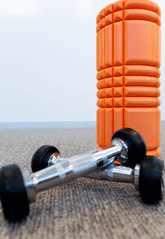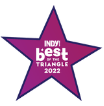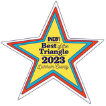
Share:
Foam rolling has become very popular in the last few years, especially in the fitness and athletic world. If you go to about any gym, you will see someone rolling around on a foam roller. And yes, some of you look more graceful than others. If you are one of the people that feel like you are flopping around like a fish out of water, then this is the blog for you. If you have ever wondered what all the hype is about and what rolling around on a piece of foam can do to benefit you, this is also the blog for you. In this blog, I am going to provide specific parameters for rolling for a warm-up and recovery, highlight theories on how it works, and demonstrate rolling with videos.
Warm-Up
If you are like me and many of my patients, you view a warm-up as optional and possibly, an inefficient use of time. Simply put, that is not true. There is a reason a warm-up is included in pregame before every sporting event. Warm-ups can reduce risk of injury and improve performance.
Now that you know you should be doing a warm-up, why would you want to include foam rolling? The short answer is that foam rolling has been shown to improve range of motion temporarily without detrimental effects to strength and athletic performance. Improved range of motion of your joints before exercise/sport can decrease the stress you place on them and improve your movement efficiency.
Wait, so if the goal is to improve range of motion, why not just stretch? The short answer is you can pick between foam rolling and dynamic stretching. Dynamic stretching has very similar results to foam rolling, but static stretching more than 60 seconds should be avoided before high intensity exercise. Static stretching has demonstrated negative results in terms of muscle power output, which is important to athletes.

There is not much evidence of combining foam rolling with dynamic stretching, but so far it appears that combining them yields better results than either separately. Foam rolling provides additional range of motion and following it up with dynamic stretching allows you to work into your body’s new available range of motion gained by the foam rolling, creating further gains in range of motion.
Specific Pre-exercise Rolling Recommendation
- Foam roll for 60-90 seconds per muscle with each roll 2-4 seconds long
- Move into the improved range of motion gained with dynamic stretching for at least 10 repetitions each movement
Example: I am going to work on speed training, and I know the hamstrings are very important for speed work. I would like to avoid “pulling a hammy,” so I roll out the hamstrings and then perform a walking toe touch or inch worm exercise before my speed training.
Foam Rolling Theories for improving Range of motion:
There is no consensus on how foam rolling works but for those of you interested, I have listed the different theories below.
- Receptors in muscle are stimulated, decreasing sympathetic nervous system input and relaxing muscle, allowing for more movement as a result
- Parasympathetic activation from hormones released causing reduce pain perception, allowing for more motion
- Rolling induced tolerance to stretch, which allows for movement beyond the previous level of restriction
- Pressure from foam rolling reducing tissue fluid viscosity (thickness) resulting in less resistance to movement

In addition to a warm-up, foam rollers can be used for improved recovery after a workout. The main benefits for using foam rolling for recovery is improved perception of pain and muscle performance recovery. After rolling, studies have shown people have higher pressure pain thresholds. Pressure pain thresholds are used to test muscle/tissue sensitivity, and they involve applying a progressively intense stimulus over an area muscle until pain is elicited. Essentially, the rolled muscle can handle more pain compared to the non-rolled muscle. The rolled muscle also recovers quicker on performance measures of speed and strength with post-exercise rolling. This effect is relatively small and may only be important to consider with elite level athletes.
Specific Post-exercise Rolling Recommendations
- Foam roll for at least 60 seconds per muscle group and up to 3 minutes
- If you are stretch for a cool down (which is recommended for most people), foam roll first, then stretch. Static stretching is recommended during a cool-down, which is different than a warm-up.
Example: I just finished a run, and my calves are sore, which is a very real issue for me. I decide to get out my foam roller and roll for 1-3 minutes. After my soreness is feeling better, I stretch to continue to cool down and utilize the range of motion gained with foam rolling.
Recovery Theories
- Facilitated process of restoring soft tissue
- Enhance post-exercise recovery of dynamic performance measures via systemic biomechanical effects (explaining these effects is beyond the scope of this blog)
- Improved muscle soreness (perception of pain) allows for improved muscle function because muscle soreness/pain impairs muscle performance
Now, that I have covered the main reasons to foam roll and theories behind why , below the videos give demonstration on how to do foam rolling.
Calves
Hamstrings
Quads
Lateral Hip and Iliotibial Band
Gluteals
Back (Lumbar and Thoracic Spine)
Lats
Pecs
Shoulder Blade and Upper trapezius
Final Thoughts
You do not have to drink the “cool aide” with the foam rolling craze to use it efficiently and effectively. It is meant to be an adjunct tool and not to take place of a thorough warm-up or recovery.
Disclaimer: This content is designed for information & education purposes only and is not intended for medical advice. Please consult a healthcare professional for advice regarding your specific health needs.
Author: Dylan Michel, PT, DPT
Resources
- Behm DG, Alizadeh S, Hadjizadeh Anvar S, Mahmoud MMI, Ramsay E, Hanlon C, Cheatham S. Foam Rolling Prescription: A Clinical Commentary. J Strength Cond Res. 2020 Nov;34(11):3301-3308. doi: 10.1519/JSC.0000000000003765. PMID: 33105383.
- Macdonald GZ, Button DC, Drinkwater EJ, Behm DG. Foam rolling as a recovery tool after an intense bout of physical activity. Med Sci Sports Exerc. 2014 Jan;46(1):131-42. doi: 10.1249/MSS.0b013e3182a123db. PMID: 24343353.
- Wiewelhove T, Döweling A, Schneider C, Hottenrott L, Meyer T, Kellmann M, Pfeiffer M, Ferrauti A. A Meta-Analysis of the Effects of Foam Rolling on Performance and Recovery. Front Physiol. 2019 Apr 9;10:376. doi: 10.3389/fphys.2019.00376. PMID: 31024339; PMCID: PMC6465761.
Get in touch with us
* indicates required fields





